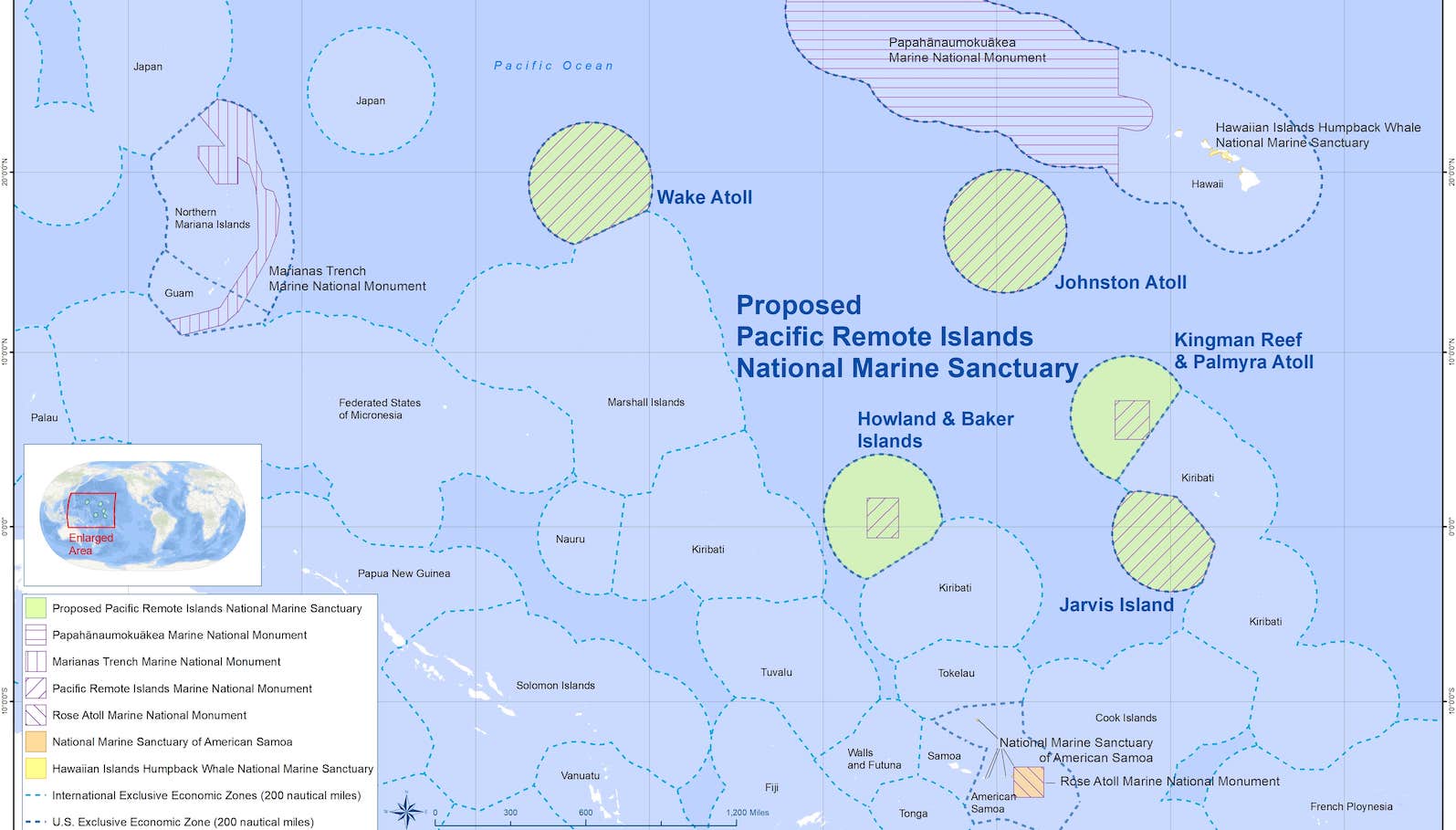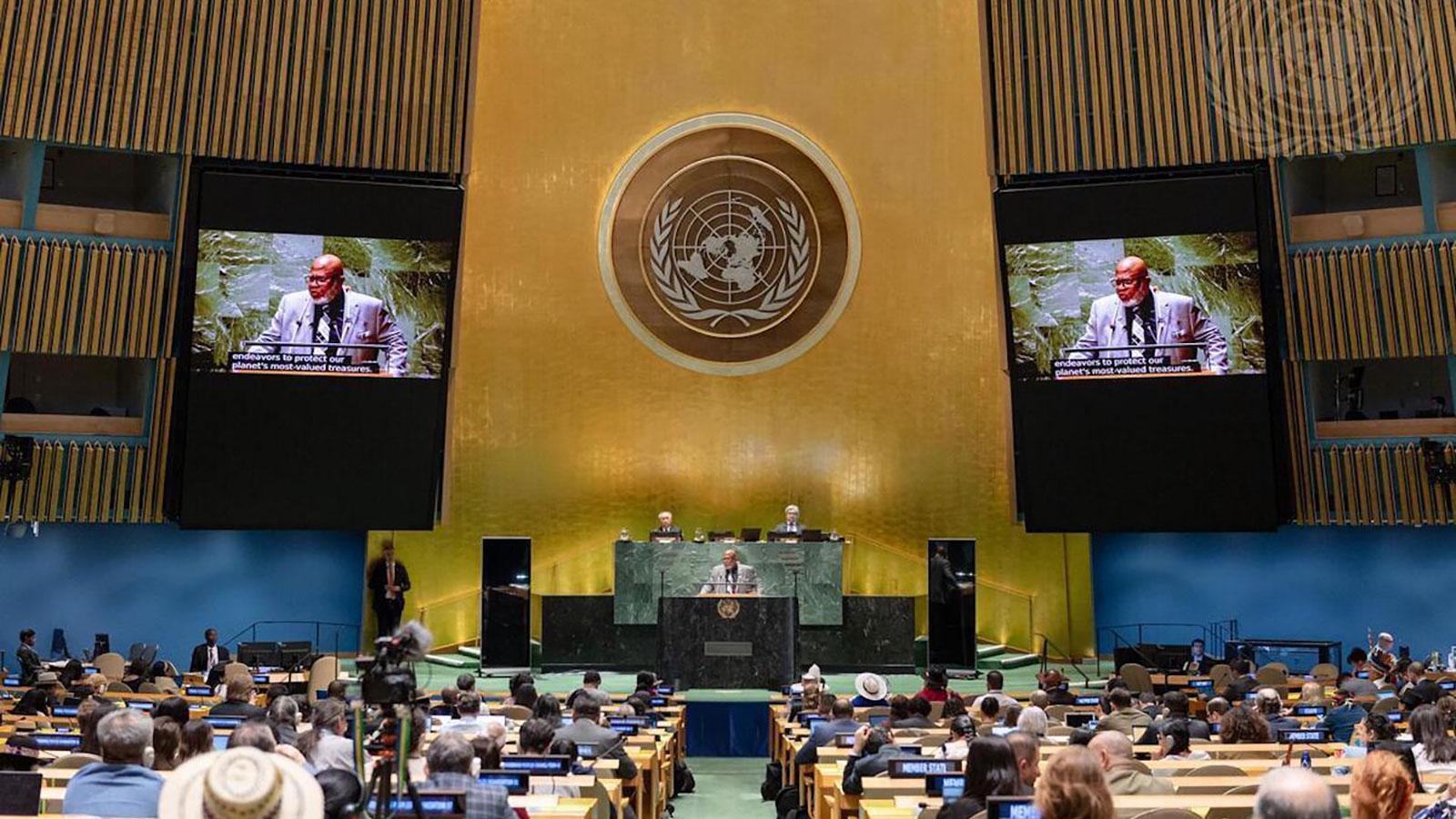President Biden’s administration wants to create the largest non-contiguous protected ocean area in the world, but a new paper says the effort is failing to take into account the rights and perspectives of the Indigenous peoples most affected by the change.
The Pacific Remote Islands Marine National Monument was established in 2009 and currently preserves nearly half a million square miles of ocean surrounding seven islands in the central and western Pacific. The Biden administration is seeking to strengthen environmental protections by overlaying and expanding the area of protection up to 770,000 square miles and designating it as a national marine sanctuary. The monument already bans commercial resource extraction like deep-sea mining, but the proposed sanctuary would both expand the protected waters and give the whole area an additional layer of federal protection.
The expansion would also make a dent in the Biden administration’s goal to conserve 30 percent of the country’s land and waters by 2030.

Courtesy of NOAA
However, according to Angelo Villagomez and Steven Manaʻoakamai Johnson, authors of the peer-reviewed article in Environmental Justice, the Biden administration has privileged Native Hawaiian perspectives (who are supportive of the expansion, which does not extend to the archipelago) over those of other Indigenous Pacific Islanders, namely Micronesians and Samoans, who have less political power in the U.S. system and have voiced more concerns about the proposal.
“Anti-Micronesian bias and colonialism are harming efforts to protect and manage waters surrounding U.S. overseas territories in the Pacific Islands,” the authors wrote. “The proposal is problematic because it has failed to meaningfully include the Indigenous people who live closest to the region and who have the strongest historical and cultural ties to the islands — Micronesians and Samoans.”
Villagomez, a senior fellow at the Center for American Progress who is Chamorro and grew up on the Mariana Islands, has been advocating for ocean-protected areas for more than 15 years. When he began this work, back in 2007, Villagomez sought to organize support in the Commonwealth of the Northern Mariana Islands for the Marianas Trench National Marine Monument, which conserves nearly 100,000 square miles of water in the Marianas archipelago. Although the proposal faced pushback from locals who were concerned that the move infringed on Indigenous sovereignty, Villagomez thought the monument would not only help the planet but also bring federal jobs to the territory. He was in the room celebrating when then-President George W. Bush signed the monument into existence in 2009, hailed as a major environmental achievement.
For years afterward, Villagomez watched as government jobs for the monument were concentrated in Hawaiʻi. The office was located in Honolulu, thousands of miles away from the monument. Research vessels were being outfitted out of Honolulu and staffed with people who were from Hawaiʻi and other states. It was disappointing to see that these benefits weren’t helping the people of the Northern Marianas, which has a much more fragile economy. After all, he had seen how the 2006 Papahānaumokuākea National Marine Monument in the northern Hawaiian islands had given Hawaiʻi a boost of prestige and research funding.
“We were working under the assumption that [the Marianas monument] would operate like [the one in] Hawaiʻi,” Villagomez said. “But the difference is Hawaiʻi has two senators, and they have representation in the House of Representatives, and they can vote for president. And we just don’t have the political power to bring the dollars to our islands the way that Hawaiʻi does.”
Only recently has an office for the Marianas Trench monument opened in the Commonwealth. And just last month — 15 years after monument designation — the Interior Department released a proposed management plan for the Marianas Trench monument. Villagomez thinks the delays reflect a broader disregard for the territories that he’s seeing unfold again in the Pacific Remote Islands sanctuary designation effort.
“The process of colonization doesn’t only play out with the colonizer and the colonized, but it also plays out in relationships between colonized people,” said Steven Manaʻoakamai Johnson, Villagomez’s co-author who is an assistant professor of natural resources and the environment at Cornell University. “In this case, what we’re trying to highlight is that the Hawaiian perspective and the Hawaiian voice is being privileged, above that of the Micronesian and Samoan voice.”
For instance, the official community group advising government agencies about the monument includes a designated Native Hawaiian representative but not an equivalent role for other Indigenous peoples, Villagomez and Johnson wrote.
Similarly, in documents describing the cultural importance of the islands, advocates for the marine sanctuary often describe the sacrifices of Native Hawaiians who lived on Howland, Baker, and Jarvis Islands during World War II, and ignore the comparable sacrifices of Indigenous Chamorros killed on Wake Island and the fact that most of the islands within the monument’s coverage are part of the Micronesian region, Villagomez and Johnson wrote.
Sarah Marquis at the National Oceanic and Atmospheric Administration said the agency plans to release a draft plan for the sanctuary designation later this year and will accept further public input on the proposal then. “We cannot comment on specific papers or articles at this stage of designation,” she said.
Naiʻa Lewis, a member of the Pacific Remote Islands Coalition that has been advocating for the sanctuary designation, said the group has long advocated for inclusivity through avenues like co-management and renaming.
“It’s really important when we are critiquing frameworks that we feel like do not support our communities and our perspectives that we also highlight people, organizations, and communities that are working in that space to make those changes,” Lewis said.
Villagomez said a major impetus for releasing the paper is the importance of Pacific territories to the U.S.’s ocean conservation goals: 29 percent of the country’s ocean territory surrounds Guam, American Samoa, and the Commonwealth of the Northern Mariana Islands, and 99 percent of the country’s protected ocean areas are in the Pacific region. Villagomez said he would like to see the territories accrue benefits from those protected areas, such as jobs and funding, but said sometimes they can’t even get their own people on the boats that explore those waters.
In American Samoa, political leaders have long opposed monuments that restrict commercial fishing. Even though conservation supporters point to a recent study that shows relatively few ships that dock in Pago Pago, its primary port, actually fish in the proposed Pacific Remote Islands sanctuary area, fears about economic harm persist. These concerns are particularly resonant when the islands’ struggling economies continue to fuel major outmigration and make it difficult for territories to provide essential medical care for their residents.
In the Northern Mariana Islands, commercial fishing is not a major industry, but critics of the marine monuments have argued that closing off large portions of the ocean to potential economic activity violates their right to Indigenous economic self-determination and is especially egregious when those same areas remain open to U.S. military undersea sonar training and explosive testing.
“Our already disadvantaged and marginalized communities carry a disproportionate burden for meeting national conservation goals,” the governors of American Samoa, Northern Mariana Islands, and Guam wrote in a joint letter to Biden last year.
Villagomez and Johnson both support ocean conservation but argue that any marine sanctuary designation should include dedicated funding for the affected territories and peoples, and urge NOAA to create such a fund.
“It’s the territories who are living with the decisions,” Villagomez said. “But it’s people in Washington D.C. and Honolulu who are forcing the territories to carry these burdens for the rest of the country.”
This story was originally published by Grist with the headline A Biden effort to conserve oceans is leaving out Indigenous peoples, report finds on Jul 3, 2024.

